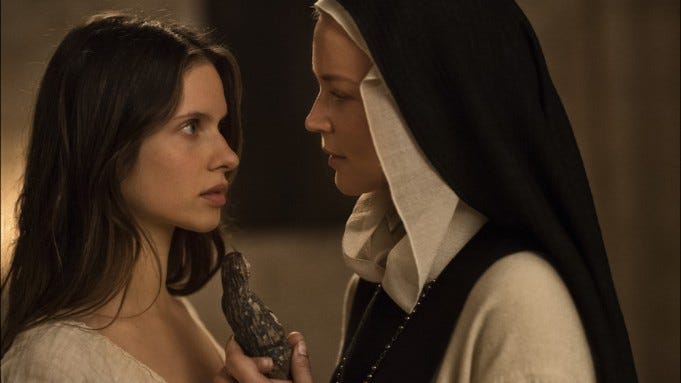Benedetta
Controversial filmmaker Paul Verhoeven returns with "Benedetta," which is likely to titillate some and infuriate others.
This review is free content for everyone. If you like what you see, please support Film Yap with a subscription, now at a huge discount!
Director Paul Verhoeven is the antithesis of the Bush song “Everything Zen,” as there’s still most definitely sex in his violence.
I find it absolutely hilarious that at 83 years old everyone’s favorite perverted Dutch filmmaker has returned with the lesbian nunsploitation picture “Benedetta” … and he’s surprised that folks are offended. (The movie opens in select theaters Friday, Dec. 3 including Indianapolis’ Landmark Keystone Art Cinema and Living Room Theaters as well as Avon, Ind.’s AMC Perry Crossing 18. It will also be available to stream beginning Tuesday, Dec. 21.)
I’m agnostic. I’ve got no horse in the race. I wasn’t offended by “Benedetta” per se, but I can certainly understand why people of faith would be. (Hell, I could see lesbians being rankled too. Who better to convey the sex lives of two young women than an 83-year-old white dude?) What did Verhoeven expect to happen when he includes a sequence of a nun taking a miniature wooden statue of the Virgin Mary, carving its legs into a dildo and inserting said sculpture into another nun’s nethers? This shit might fly in Western Europe, but it’s likely to piss off puritanical Americans.
Verhoeven has reunited with his “Elle” co-screenwriter David Birke in adapting Judith C. Brown’s book “Immodest Acts: The Life of a Lesbian Nun in Renaissance Italy,” which tells the tale of our titular nun.
Benedetta is taken to an abbey in Tuscany as a child (Elena Plonka) where she’s promised to God by her father (David Clavel) as an offering of thanks for allowing mother (Clotilde Courau) and daughter to survive a particularly difficult birth. Shortly after her arrival Benedetta is touched by a miracle when whilst praying a statue of the Virgin Mary topples atop her. The statue should’ve crushed the girl … but alas Benedetta is unharmed. (In a bit of foreshadowing that’s about as subtle as a sledgehammer, Verhoeven has the child kiss the statue’s bare breast when trapped beneath it.)
We flash forward 18 years. Benedetta (now played by fellow “Elle” alum Virginie Efira) has grown into a respected member of the convent. This is all upended upon the arrival of Bartolomea (Daphne Patakia of the Yorgos Lanthimos short “Nimic”), who bursts into the abbey demanding protection from her abusive father who’s in pursuit. Benedetta convinces her father … who’s conveniently enough visiting at this particular time … to pay Bartolomea’s dowry so she too may stay and also become a Bride of Christ. The two women take a shine to one another immediately and ridiculously begin flirting while sitting side-by-side on the crapper. (What is this, the “Battleshits” scene from “Harold & Kumar Go to White Castle”?)
As Benedetta’s feelings for Bartolomea intensify so too do the miracles that surround her. She often has vibrant, violent visions of Christ rescuing her. She also begins experiencing stigmata (it’s certainly suggested that this is self-inflicted) and starts speaking in a guttural voice as if she were a direct conduit to God. Abbess Felicita (the esteemed Charlotte Rampling) is concerned with Benedetta’s well-being and assigns Bartolomea to care for her. The women grow closer still.
As word of Benedetta’s miracles spreads throughout the church and the village, she usurps Felicita’s power and becomes abbess herself. Felicita and her daughter Christina (Louise Chevillotte) are disgusted by this development and seek an outside investigation from the hypocritical Le Nonce (Lambert Wilson, The Merovingian from “The Matrix” movies).
If Verhoeven’s a pervert, then so am I, as it was prurient interests that led me to “Benedetta.” Well, that and a rampant fandom for the filmmaker, though I must admit I prefer Verhoeven’s American works from my childhood and teenage years as opposed to his artier, European efforts of late. “Benedetta” is many things – satire, smut, academic exercise, blasphemy – most importantly it’s never boring.





